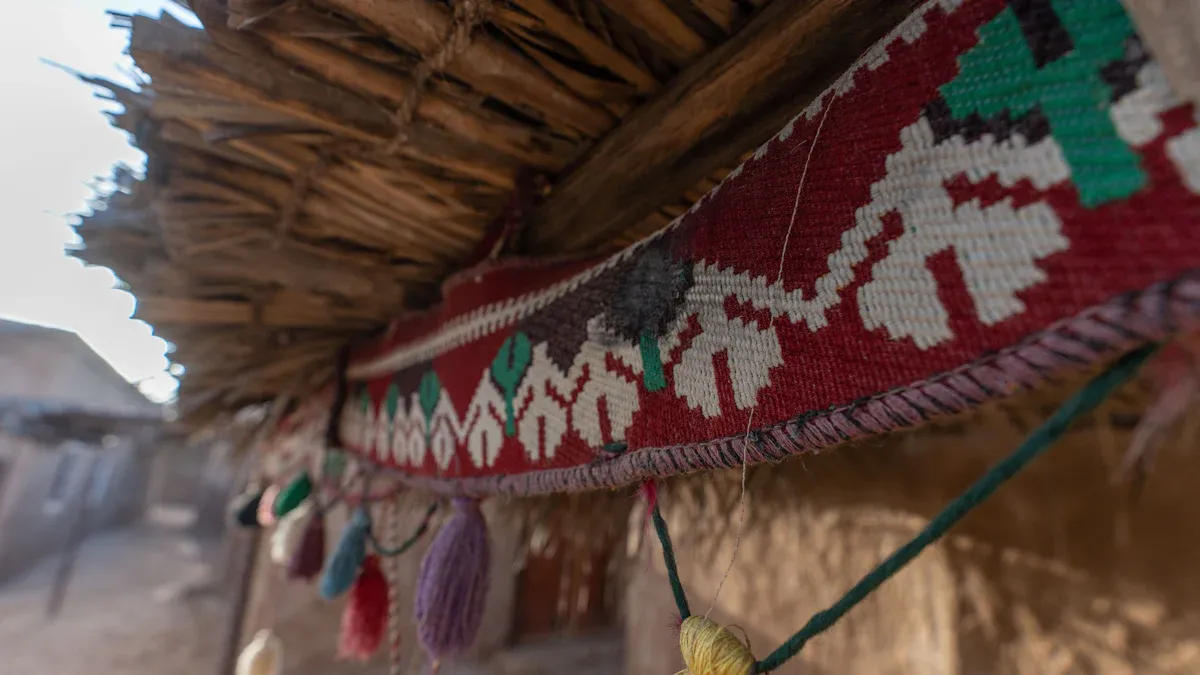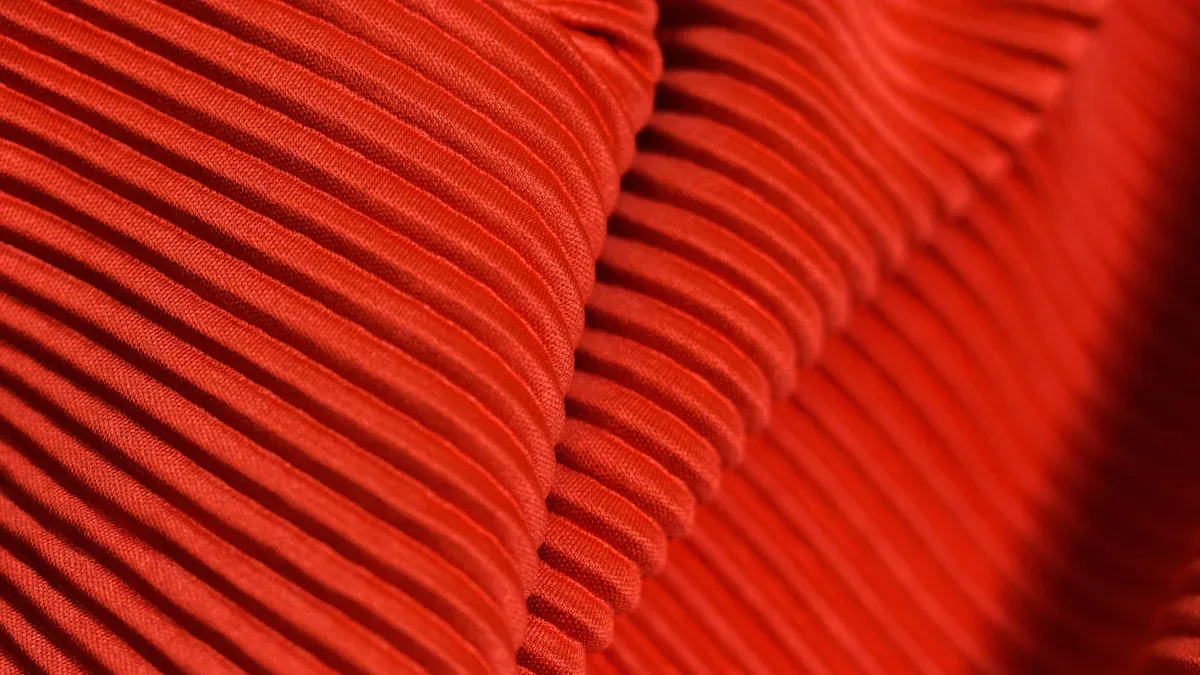
You can make a better choice for the environment by choosing linen organic fabric for your home. Linen sheets offer breathability and comfort while supporting sustainability. As you enjoy eco-friendly linen sheets, you help create a planet-friendly and sustainable home. Linen organic fabric stands out for its eco-friendly qualities, including durability and biodegradability. Many people select linen sheets for their sustainable and eco-friendly benefits, which support sustainable living and protect our planet.
Key Takeaways
- Organic linen fabric comes from flax plants grown without harmful chemicals, making it eco-friendly and biodegradable.
- Choosing organic linen saves water and reduces pollution compared to cotton and synthetic fabrics.
- Certified organic linen meets strict environmental and social standards, ensuring safe and fair production.
- Linen products last long, reduce waste, and break down naturally, supporting a cleaner planet.
- Using organic linen in bedding, curtains, and kitchen textiles creates a healthier, sustainable home.
What Makes Linen Organic Fabric a Better Choice for the Environment
Natural Origins and Organic Certification
You choose a natural fabric when you select linen organic fabric for your home. This fabric comes from 100% flax linen, a plant-based material that grows well without synthetic chemicals. As a natural fiber, organic linen stands out for its purity and eco-friendly qualities.
When you look for organic linen, you should check for trusted certifications. These certifications guarantee that the fabric meets strict environmental and social standards. The Global Organic Textile Standard (GOTS) is one of the most recognized certifications. GOTS requires:
- Use of organic flax grown without artificial fertilizers or pesticides
- No genetically modified organisms (GMOs)
- Sustainable farming practices
- Fair labor, no child labor, and fair wages
- Strict chemical controls during processing, banning harmful dyes and chlorine bleach
Other respected certifications include the European Flax charter and ICEA, which also ensure sustainable materials and ethical production.
How Organic Linen Differs from Conventional Fabrics
You make a sustainable choice when you pick organic linen over conventional fabrics. The differences become clear when you compare their production processes and environmental impacts.
- Linen organic fabric uses minimal water and avoids synthetic pesticides.
- Organic linen farming supports healthy soil and reduces pollution.
- 100% flax linen is biodegradable and returns to the earth safely.
- Conventional cotton needs more water and chemicals, which can harm the environment.
- Synthetic fabrics rely on fossil fuels and do not break down naturally.
| Fabric Type | Production Process Characteristics | Environmental Impact Highlights |
|---|---|---|
| Organic Linen | Grown without synthetic pesticides or fertilizers; minimal chemicals; natural biodegradability | Avoids synthetic chemicals; promotes sustainability; biodegradable |
| Conventional Cotton | Requires significant water use; uses synthetic pesticides and fertilizers | Higher water consumption; chemical pollution |
| Synthetic Fabrics | Produced from fossil fuels; complex chemical processes | High fossil fuel use; non-biodegradable; environmental harm |
You support a cleaner planet when you choose sustainable materials like organic linen. This natural fabric offers a responsible alternative to conventional options and helps you create a healthier home.
Key Environmental Benefits of Organic Linen

Low Water Usage in Flax Cultivation
You help conserve water when you choose organic linen for your home. Flax, the plant used to make 100% flax linen, thrives with minimal water usage. In fact, flax needs only about 400 liters of water to produce one kilogram of fiber. Cotton, by comparison, can require up to 20,000 liters for the same amount. This means flax uses about 50 times less water than cotton. You support eco-friendly living by selecting a fabric that places less strain on the planet’s water resources.
Water conservation stands as one of the most important environmental benefits of organic linen. You make a positive environmental impact every time you select linen over water-intensive fabrics.
Minimal Chemical Inputs and Pesticide-Free Farming
You protect the environment when you choose organic linen. Flax cultivation for organic linen involves low chemical impact. Farmers do not use synthetic fertilizers or pesticides. This approach keeps harmful chemicals out of the soil and water. You also avoid exposure to residues that can remain in conventional fabrics.
- Organic linen farming supports healthy soil.
- You reduce pollution by choosing pesticide-free products.
- The low chemical impact of organic linen helps preserve local ecosystems.
You support a cleaner and safer planet by making eco-friendly choices in your textiles.
Biodegradability and Compostability
You contribute to waste reduction when you use organic linen products. Linen is both biodegradable and compostable. When you finish using a linen item, it breaks down naturally. Unlike synthetic fabrics, organic linen does not leave toxic residues in the environment.
| Fabric Type | Biodegradable | Compostable | Environmental Impact |
|---|---|---|---|
| Organic Linen | ✅ | ✅ | Low, eco-friendly |
| Synthetic Fabrics | ❌ | ❌ | High, polluting |
You help close the loop in the textile lifecycle by choosing compostable and eco-friendly materials. Organic linen returns to the earth safely, supporting a sustainable future.
Durability and Waste Reduction
You want your home textiles to last. Organic linen stands out for its impressive strength and long lifespan. Flax fibers, which make up organic linen, have natural durability. This means your linen sheets, curtains, and tablecloths can handle regular use and washing without wearing out quickly.
- Organic linen resists pilling, so your fabrics keep a smooth look over time.
- The fabric softens with each wash, giving you more comfort while keeping its strength.
- You can easily care for organic linen. Most items are machine washable and dryable, which helps them last longer.
- High-quality linen can last as long as synthetic fabrics like polyester if you follow proper care steps.
- The weave and quality of the fabric matter. Well-made organic linen products stay strong for years.
You help the planet when you choose textiles that last. Durability reduces waste because you do not need to replace your items as often. Recent waste management reports show that organic linen breaks down faster than other natural fibers. Its structure allows for quick enzymatic breakdown, so you can compost old linen products instead of sending them to landfills. Linen made from pure flax biodegrades much faster than blends with synthetic fibers, which do not break down at all. By choosing organic linen, you support waste reduction and help keep the environment clean.
Tip: Store your linen in a cool, dry place and avoid overloading your washing machine. These simple steps will help your linen last even longer.
Carbon Capture and Reduced Emissions
You make a positive impact on the environment when you select organic linen. Flax crops, used to produce linen, have a lower carbon footprint than many other fibers. Flax needs less water and fewer chemical inputs, which means fewer greenhouse gases enter the atmosphere.
- Flax fiber’s carbon footprint ranges from about 0.9 kg to over 11 kg CO2-equivalent per kilogram, depending on farming practices.
- Cotton, by comparison, can have a carbon footprint up to four times higher.
- Flax uses about three times less water per kilogram of fiber than cotton.
- The lower carbon footprint of flax means organic linen helps reduce overall greenhouse gas emissions.
You can see how organic linen compares to conventional textiles in the table below:
| Aspect | Organic Linen (Flax) | Conventional Textile (e.g., Cotton) |
|---|---|---|
| CO2 Emissions (per 1kg) | ~16.7 kg CO2 eq | ~16.4 kg CO2 eq (cotton), higher for others |
| Water Use | Relies on rainwater, no irrigation needed | High irrigation, ~10,000 liters per kg cotton |
| Pesticide Use | Very few or none | Heavy pesticide use |
| Water and Soil Pollution | Minimal due to low pesticide and no irrigation | Significant due to pesticides and chemical processing |
| Biodegradability | Yes | Varies, often less environmentally friendly |
You help lower emissions and support a healthier planet by choosing organic linen. This fabric’s production process uses fewer resources and creates less pollution than conventional textiles. When you pick organic linen, you take a step toward a more sustainable future.
Practical Uses of Linen Organic Fabric in the Home

Linen Sheets and Bedding
You can transform your bedroom into a healthier space by choosing organic linen bedding. Linen sheets offer exceptional breathability, keeping you cool in summer and warm in winter. When you use linen bedding, you reduce your exposure to harmful chemicals because these products are made without synthetic pesticides or fertilizers. Certified organic linen bedding, such as those with GOTS or OEKO-TEX labels, meets strict safety standards. You enjoy natural antibacterial properties, which help maintain hygiene and reduce the need for frequent washing. Over time, linen sheets become softer, enhancing your comfort with every use. By selecting organic linen bedding, you support eco-friendly living and create a sustainable decor for your home.
Tip: Organic linen bedding helps minimize allergens and supports a restful night’s sleep.
Curtains and Window Treatments
You improve your home’s comfort and energy efficiency when you install linen curtains. Linen curtains use the natural insulating qualities of flax fibers to help regulate indoor temperatures. In summer, linen curtains keep rooms cool by blocking excess heat. In winter, they help retain warmth. You also benefit from improved airflow, as linen curtains promote ventilation and prevent stuffiness. Because linen curtains are free from harmful chemicals and volatile organic compounds, you reduce indoor air pollutants and create a healthier environment. The biodegradable nature of linen curtains ensures your home remains eco-friendly and toxin-free.
- Linen curtains support energy savings by reducing the need for heating and cooling.
- You protect your family’s health by choosing chemical-free window treatments.
Table Linens and Kitchen Textiles
You bring both style and sustainability to your dining area with organic linen table linens. Linen is made from flax, a crop that requires minimal water and pesticides. This makes your table linens and kitchen textiles eco-friendly choices. Linen’s durability means your napkins, placemats, and towels withstand frequent use and washing. The fabric’s natural absorbency and stain resistance make it ideal for kitchen tasks. You also benefit from hypoallergenic properties, which help protect sensitive skin. Proper care, such as cold washing and air drying, keeps your linen textiles fresh and long-lasting. By choosing these materials, you reduce waste and support a cleaner home.
- Linen table linens are biodegradable, reducing landfill impact.
- You enjoy a hygienic and sustainable kitchen with every use.
Suerte: Sustainable Linen Product Examples
You can find many brands that set the standard for sustainable linen products. These companies use organic materials, ethical production, and eco-friendly packaging. When you choose these products, you bring both style and responsibility into your home.
- Parachute Home offers linen bedding that meets Oeko-Tex Standard 100 and Climate Neutral certifications. Their goal is to use mostly organic and biodegradable materials by 2035.
- Boll & Branch leads with Fair Trade certification and FSC-certified recyclable packaging. They ensure full traceability and fair wages for workers.
- Magic Linen uses 100% European flax and Oeko-Tex-certified linen. Their made-to-order approach reduces waste, and they repurpose leftover fabric.
- Coyuchi uses organically farmed materials and avoids toxic dyes. Their Fair Trade and Made Safe certifications show a strong commitment to the environment.
- Bed Threads creates flax linen sheets with less water and fewer pesticides. Their carbon-neutral manufacturing and plastic-free packaging support a cleaner planet.
You can also look at brands like Cozy Earth, The Citizenry, Tekla, Ettitude, SÕL Organics, Quince, Avocado, Cultiver, and Brooklinen. Each of these brands focuses on sustainable practices and high-quality linen products for your home.
Suerte Textile supports your sustainable goals by offering a wide range of customizable linen fabrics. You can choose from digital printing, embroidery, dyeing, and yarn-dyeing to match your needs. Suerte’s advanced production ensures consistent quality and quick turnaround, making it easy for you to bring eco-friendly linen into your home. Their one-stop service covers everything from pattern design to production, helping you create a sustainable space with confidence.
Tip: When you select linen products from trusted brands or suppliers like Suerte, you help protect the planet and enjoy long-lasting comfort in your home.
Certifications and Ethical Production in Organic Linen
Recognized Organic Certifications
You can trust organic linen when you see respected certifications on the label. These certifications show that the fabric meets strict standards for safety, sustainability, and ethical production. Here are some of the most widely recognized certifications for organic linen:
-
Global Organic Textile Standard (GOTS):
GOTS requires at least 70% organic fiber content. You know the linen comes from flax grown without synthetic pesticides or fertilizers. GOTS also bans harmful chemicals like heavy metals and formaldehyde. The certification covers the entire production chain, including water use, waste management, and energy consumption. GOTS also ensures fair wages and ethical treatment for workers. Traceability is required, so you can follow the fabric’s journey from farm to finished product. -
OEKO-TEX Standard 100:
OEKO-TEX tests every part of the textile for over 1,000 harmful substances. The standard is especially strict for products that touch your skin, such as bedding and clothing for babies. OEKO-TEX certification means the linen is safe for you and your family. This label is recognized worldwide and helps you choose products that support both safety and sustainability.
You can compare these certifications in the table below:
| Feature | GOTS | OEKO-TEX Standard 100 |
|---|---|---|
| Organic Fiber Required | Yes (≥70%) | No |
| Chemical Restrictions | Very strict | Strict (focus on product safety) |
| Environmental Standards | Yes | No |
| Social Criteria | Yes | No |
| Traceability | Yes | No |
Tip: Look for these labels when you shop for linen to ensure you support ethical and sustainable practices.
Fair Labor and Responsible Manufacturing
You support fair labor and responsible manufacturing when you choose certified organic linen. These practices protect workers and help local communities thrive. Certified organic linen production starts with sustainable farming and continues through every step of the supply chain.
- Workers receive fair wages and safe working conditions.
- Companies protect worker welfare and support fair labor conditions.
- Transparency in sourcing and production builds trust.
- Many producers support small farmers and artisans who use traditional, sustainable methods.
Certifications like GOTS and Fair Trade guarantee that workers’ rights are respected. These standards require companies to follow international labor guidelines and provide safe workplaces. OEKO-TEX certification also promotes social responsibility by ensuring that linen is free from harmful substances and produced under ethical conditions.
When you choose linen with these certifications, you help create positive change. You support communities, protect the environment, and ensure that everyone involved in making your linen benefits from fair and responsible practices.
Choosing certified organic linen means you care about people and the planet.
You make a real difference when you choose linen sheets and linen bedding for your home. Organic linen stands out for its eco-friendly qualities, breaking down naturally and lasting for decades. Linen sheets and linen bedding support sustainable living by reducing waste and lowering your environmental footprint. You help promote ethical practices in the textile industry and create a healthier space for your family. Start your journey toward sustainable living by making the switch to linen sheets today.
FAQ
What makes linen organic fabric a better choice for the environment?
You choose linen organic fabric because it uses minimal water and has a low chemical impact. This natural fiber supports sustainability and offers environmental benefits. You help reduce waste and support planet-friendly practices by selecting sustainable materials for your home.
How does organic linen bedding support sustainable living?
You support sustainable living with organic linen bedding. This bedding uses 100% flax linen, which is compostable and eco-friendly. The durability reduces waste, and the breathability keeps you comfortable. You create a sustainable decor that benefits both your home and the environment.
Are linen sheets and linen curtains safe for sensitive skin?
You can trust linen sheets and linen curtains for sensitive skin. These products use natural fabric with no harsh chemicals. The materials are hypoallergenic and gentle. You enjoy a healthier home with sustainable, planet-friendly textiles.
What are the main environmental benefits of using organic linen in the home?
You gain environmental benefits by using organic linen. The fabric’s minimal water usage, low chemical impact, and compostable nature lower the environmental impact. You help create a sustainable, eco-friendly home with every choice.
How do I care for organic linen to maintain its durability?
You should wash organic linen in cold water and air dry it. This care keeps the natural fiber strong and extends its life. Proper care ensures durability reduces waste and supports sustainability in your home.



